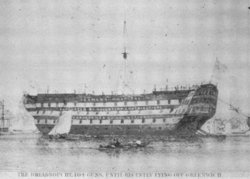HMS Dreadnought (1801)
|
|
HMS Dreadnought was a second-rate of 98 guns of the Royal Navy. She was launched at Portsmouth at midday Saturday, on 13 May 1801, after 13 years on the stocks. She was the first man of war launched since the Act of Union 1800 created the United Kingdom of Great Britain and Ireland, and at her head displayed a lion couchant on a scroll bearing the Imperial arms as emblazoned on the Standard.
The launching was a spectacle; it was reported that at least 10,000 people witnessed Commissioner Sir Charles Saxton break a bottle of wine over her stem, and that after the launch Sir Charles gave a most sumptuous cold collation to the nobility and officers of distinction.
After the launch, Dreadnought was brought into dock for coppering, and a great number of people went on board to view her. The following day, due to the exertions of Mr Peake, the builder, and the artificers of the dockyard, she was completely coppered in six hours and on Monday morning she went out of dock for rigging and fitting.
Her first commander was Captain James Vashon. After cruising for some time in the Channel he proceeded off Cádiz and Minorca where he continued until the summer of 1802.
Her first master was Mr. Banks followed by Joseph Foss Dessiou (1769–1853), who was paid off on 15 July 1802.
In 1803, Captain Edward Brace briefly took command as Flag-Captain to Sir William Cornwallis, until he was relieved that same year by Captain John Child Purvis.
Purvis served under the orders of Admiral Cornwallis until he was promoted to Rear Admiral in April 1804. The next commander until August was Robert Carthen Reynolds. He was superseded that month by George Reynolds, who, in turn, was replaced in December that year by Edward Rotheram, who stayed as flag captain to Admiral Cutbert Collingwood until just before Trafalgar. The winter gale weather off the French coast badly damaged five of the major warships maintaining the blockade. Dreadnought lost most of her powder when water poured into the magazine.
In the spring of 1805, Admiral Cornwallis was replaced by an ailing Lord Gardner who allowed the close blockade to be slackened. On 30 March the French fleet escaped from Toulon and reached Cádiz on 9 April. The French and Spanish squadrons sailed separately from there and joined forces in Martinique on 26 May. On 15 May Collingwood and his squadron of seven ships received orders from the Admiralty to sail for Barbados. Before they could depart; however, Horatio Nelson arrived from the Mediterranean Sea in pursuit of the French, and Dreadnought remained off Cádiz. Early in October 1805 Captain John Conn assumed command of Dreadnought, after having brought Royal Sovereign out from England for Vice Admiral Collingwood. Collingwood and Rotheram then moved to the newly recoppered first rate on the 10th of October 1805, leaving Conn in command of the now sluggish Dreadnought, with her barnacled hull badly in need of careening, but nevertheless with a well exercised ship's company, who for months having been under Collingwoods watchful eye, now contained the most efficient gun crews in the fleet.
At the Battle of Trafalgar on 21 October 1805, Dreadnought was the eighth ship in the lee division to enter the action. She started firing on San Juan at two o'clock and fifteen minutes later ran her on board and forced her to surrender. She then attempted to engage Principe de Asturias but the Spanish ship hauled off. During the battle Dreadnought lost seven killed and 26 wounded.
Dreadnought continued to patrol the Channel and the Baltic for another seven years, until 1812, when she was taken out of commission at Portsmouth. In 1827, she became a lazaretto (quarantine ship) at Milford. HMS Dreadnought was broken up in 1857.
See HMS Dreadnought for other ships of this name.

